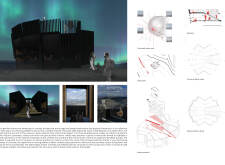5 key facts about this project
The pavilion's architectural form embodies the concept of a "charred mass," reflecting the influence of volcanic activity in the region. This design choice fosters a connection between the structure and its natural context, providing visitors with an immersive experience. The primary function of the pavilion is to serve as a viewpoint, offering various vantage points that frame the surrounding landscape while providing spaces for gathering, reflecting, and experiencing the environment.
Unique Design Approaches
One of the more distinctive aspects of this project is its emphasis on framed views. The design includes strategically positioned viewports that allow visitors to interact with specific geological features, encouraging a deeper appreciation of the natural landscapes. The interplay between open and enclosed spaces creates a sense of movement within the pavilion, enhancing user experience as they transition from intimate areas to expansive viewpoints.
Another noteworthy element is the integration of materials such as charred wood, solid wood panels, and lightweight timber modules. The charred wood façade not only addresses aesthetic considerations but also ensures durability, enhancing the building’s capacity to withstand environmental conditions. The use of lightweight timber modules reflects a commitment to sustainability and efficiency, allowing for faster construction times while minimizing site disruption.
Architectural Functionality
The spatial organization within the pavilion is carefully thought out to cater to varying group sizes and activities. The ground floor creates an intimate atmosphere with smaller gathering spaces, while the upper level provides panoramic views suitable for larger audiences. This flexibility in design encourages diverse usage patterns, adapting to different visitor experiences.
Additionally, movement within the structure is guided yet fluid, allowing users to choose their pathways. This navigational approach fosters exploration and interaction with various spaces, concluding with expansive vistas that encourage contemplation of the geological surroundings.
For more detailed insights into the architectural design, including architectural plans, architectural sections, and nuanced architectural ideas, readers are encouraged to explore the project presentation further. This allows for a comprehensive understanding of the design elements that contribute to making the pavilion a thoughtful addition to its remarkable setting.























